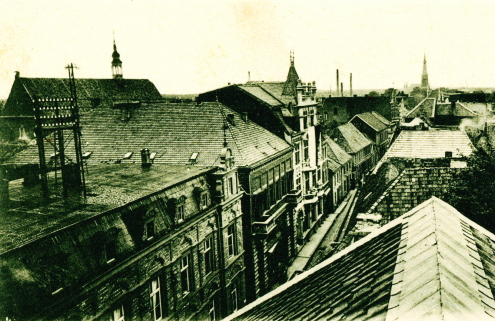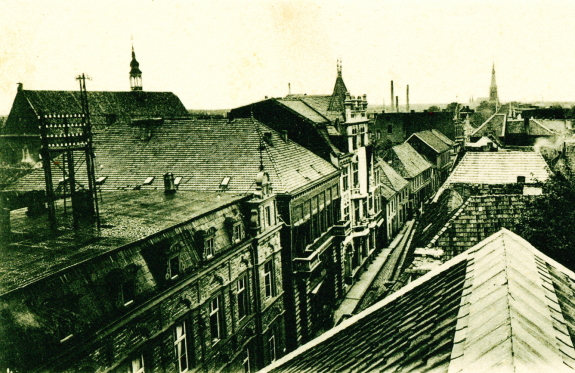Photo of the month - November 2023
When the telephone came to Bocholt

© Stadtarchiv Bocholt
In its monthly series of topics, the Bocholt city archive this time recalls the beginnings of telephony in Bocholt with a historical photo.This view, taken around 1905, could be labelled "Over the roofs of Bocholt". The viewer is standing on the roof of a house in the city centre and looking east. The Protestant church on Münsterstraße can be seen in the background. At the top left, the older part of today's Liebfrauenkirche with its baroque ridge turret comes into view.
In his shot, the photographer has also captured the Imperial Post Office at the front left and with it the technical telephony equipment towering on the roof. A telephone mast and the numerous line insulators are clearly visible here. In the past, however, this was referred to as a "telephone pole".
At that time, the telephone was a wired device. The caller's set and the call recipient's set were connected by a line. At first, it was not possible to reach other subscribers. This changed with the development of local and national telephone networks in conjunction with their exchanges. These were switching centres with the help of which telephone connections could be established by simply changing the connection lines. The telecommunications system was under the control of the Reichspost, and the exchanges were located at the post offices, where mostly women were employed as telephone operators.
"I agree with the connection"
In Bocholt, the introduction of the telephone began on 27 November 1894, when the secretary recorded in the minutes of the council meeting: "The meeting agreed to the connection of the city of Bocholt to the telephone system [...]." In June 1895, work began here on setting up the telecommunications system, as we would call it today. It took around eight weeks to install the lines. During this time, 38 subscribers had already registered for connection to the telephone network.
On 28 June 1895, the city council of Bocholt decided that "the room in front of the study" of Mayor Degener was considered a suitable place for [the] installation of the telephone station. Incidentally, the company "Aktiengesellschaft für Baumwollindustrie" on Industriestrasse, where the learning centre of the Bocholter Aa and Industriestrasse cultural quarter (kubaai) will soon open in the former Herding building, was given telephone number 1 in Bocholt after it was activated.



